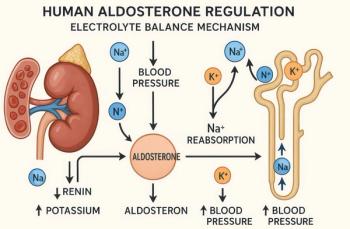
Older Man with Cough and Shortness of Breath: A Surprising Diagnosis
Simultaneous events can confuse a clinical picture. In this case, the ECG offers clues to an event that occurred during an episode of bronchitis.
History: A 73-year-old man presents to the emergency department (ED) in the evening after a day of progressively worsening shortness of breath and dyspnea on exertion that began when he woke at 7:00 am. He has had a cough for about a week with a lot of green phlegm, but states that neither is any worse today. His dyspnea became significantly worse this evening so he had his wife drive him to the hospital. His past medical history is notable for CHF, CABG, COPD, and glaucoma. He denies any fever, chest pain, leg swelling, or other complaints.
Examination: Vital signs are normal except for a pulse of 104, and a respiratory rate of 22. Physical exam results are normal except for ronchi and coughing with a lot of pale yellow phlegm, which the patient insists on showing the ED staff. There is no JVD on neck examination or rales or wheezing. The heart is tachycardic without murmurs. There is no peripheral edema or calf tenderness.
Initial Concerns: • COPD
• Pulmonary embolism
• Acute coronary syndrome
• Congestive heart failure
Testing: • Chest x-ray: Clear
• EKG: See Figure 1(Please click to enlarge)
Questions:
1. What does the case EKG show? 2. What’s the next step?
3. Where can I get a quick refresher on this topic?
Please click "next" for answers and discussion.
Answers1. What does the case EKG show? The EKG shows an inferior STEMI with reciprocal changes. The patient’s baseline EKG (from several months ago) is shown in Figure 2. (Please click to enlarge)
2. What’s the next step? Call cardiology. Cardiology saw the patient and wanted to wait for troponin results, rather than go to the cath lab. (See Case Conclusion, below, for results.)
3. For a quick refresher on this topic--see highlighted area in Figure 3 (Please click to enlarge)
Discussion
There are many lessons from this case, but I will focus on troponin testing. (See Case Conclusion for a few other lessons.) It is important to be aware of the kinetics of cardiac troponin and reasons for normal troponin results in true acute coronary syndromes. It is also important to routinely return to the bedside after a normal troponin result to confirm or improve the accuracy of your understanding of the timing of the chest pain episodes so that you can correctly interpret your initial troponin result.
Although newer troponin assays are more sensitive than older ones, keep in mind that while troponin levels after an MI usually rise enough to reach detectable levels within 3 to 6 hours, they may not peak for 24 hours.
When to start the clock? Most studies use arrival to the hospital because that is easy to measure when dealing with thousands of patients. In an individual patient, however, it may make more sense to ask the patient if the pain or other anginal equivalent is ongoing and when it peaked. Sometimes this may occur in the waiting room or after arrival. Sometimes it was a day prior. You have to ask to find out. It is also critical to know how long the pain episodes last. Episodes that last less than 20 minutes may never cause a bump in troponin. Basically, the longer and more severe an episode was, the more likely it will be to cause an eventual rise in troponin. The shorter or milder an episode was, the more likely you are to get a normal troponin-even if it is true unstable angina.
For the reasons noted above, it is always wise to take a second history before ordering a second troponin. If there have been no symptoms in the past 6 hours, there is often little utility in repeating a troponin. If the symptoms are episodic and last only minutes, there may also be almost no use in repeating the troponin other than giving you a potentially false sense of security in a patient with unstable angina.
Case Conclusion: The initial troponin was <0.01 µg/L; a followup level at 2.5 hours after hospital arrival was 0.03 µg/L (still normal); a third troponin at 7.5 hours was 0.80 µg/L; at 24 hours, the troponin peaked at 6.49 µg/L.
Lessons
1. Though rare, repeat troponins may miss an MI in the first 2 hours. If there is ANY rise, get another troponin.
2. When there is dyspnea with a normal chest x-ray and pulse-ox, always consider both MI and PE, even in the absence of chest pain. Many clinicians are unaware that the larger a PE, is the less likely it is to cause pain.
3. Sometimes 2 things happen simultaneously. This patient just happened to have a STEMI during an episode of bronchitis.
Resources
Excerpt on TROPONINS from
Newsletter
Enhance your clinical practice with the Patient Care newsletter, offering the latest evidence-based guidelines, diagnostic insights, and treatment strategies for primary care physicians.





























































































































































































































































































































